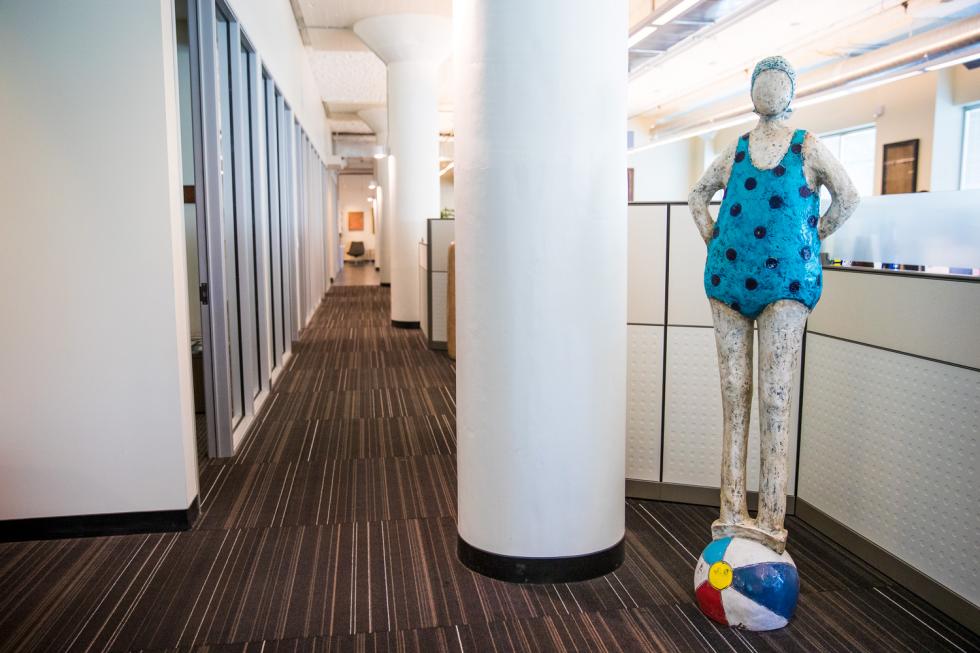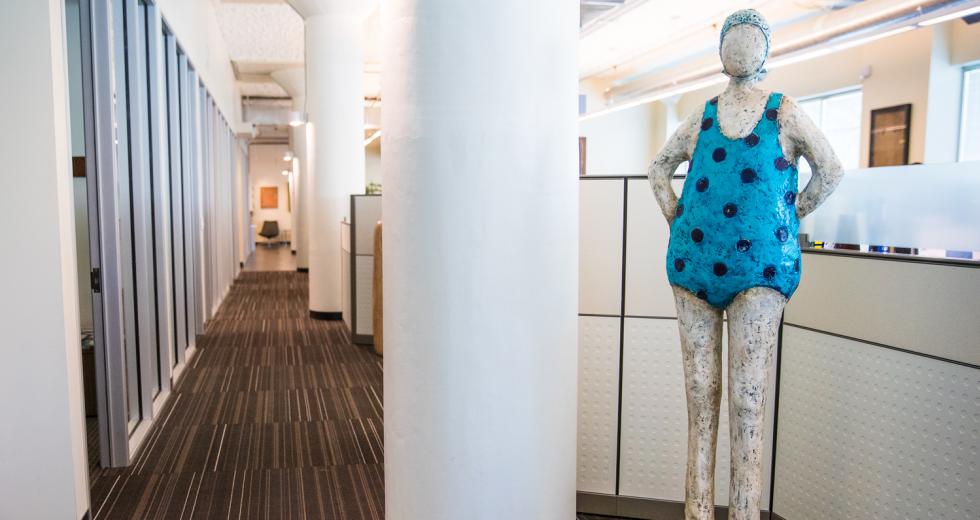When you walk into the offices of Sacramento-based communications firm Runyon Saltzman, you’ll see a small model of an antique red tricycle. Matching red swivel chairs. A ceramic sculpture of a woman sitting atop a car with big red lips and a glass hat.
And then there’s the statue. The firm’s co-founder, Estelle Saltzman, bought the concrete, 6-foot-tall sculpture of a woman standing on a beach ball with hands on her hips from Davis-based artist Cindy Wilson. “It’s a fantastic piece, and it’s got a good sense of humor,” Saltzman says.
When she brought the piece into the office, Saltzman says she told employees there would be a naming contest for the beach-ball lady, and she would take the winner to lunch at Ella Dining Room. Five employees came up with the exact same name: Dotty. “That created lots of conversation — although I did have to take five people to lunch,” Saltzman says, laughing.
Dotty is a prominent fixture of the workspace, and it’s not uncommon for people to pose with her for pictures. This boosts morale. This builds teamwork. “She’s become kind of a mascot.” Such is the power of art.
Art in the workplace is more than cosmetic; it can actually improve employee attitudes, performance, and even the company’s bottom line. This feels almost blasphemous. By definition, we think of “art” and “profit” as two distinct and even clashing concepts, with the unspoken assumption that chasing profits will corrupt art, and that art drags down profits. Conventional wisdom says “art for art’s sake”: Art is not a means to an end, art is the end.
Perhaps. Yet researchers have found that art confers a quantifiable benefit to job performance — and could make us happier, healthier and more likely to impress a client. An indulgence or a savvy business tool? Maybe both…
Art and Productivity
Sarah Redeen, an interior designer and Sacramento director of the International Interior Design Association, frequently sees her clients skimp on artwork. “People think it’s just a ‘nicety,’ and they don’t realize that it adds so much value,” Redeen says. “But art sparks creativity. It sparks imagination. And it gives your employees a sense of pride.”
This is not some touchy-feely mumbo-jumbo. “Just as ergonomic studies have shown that you should get up from your desk every hour and walk around, the same is true for your mind,” she continues. “When you have something interesting on the wall, it gives employees something to think about when they need a break.”
Research backs up the theory. Dr. Craig Knight, from the UK’s University of Exeter, has dedicated his career to studying the impact of workplace design on job performance. In trial after trial, his team has found a link between a pleasant environment and improved output. Art is central to this. “If you own a zoo, the least you can do for a zoo animal is to make his enclosure more interesting,” he says, “And office workers are the same way.” In one 2010 study, Knight and his co-author S. Alexander Haslam split workers into four different groups to then work in four different office environments:
Lean: Your typical Office Space-type setting, this environment consisted of a sea of gray desks and cubicles free of distractions. No clutter, no plants and no artwork.
Enriched: The space was decorated with art and plants, including “several large, bright Georgia O’Keeffe-style pictures.”
Empowered: Workers were given art and plants, and then allowed to rearrange to their hearts’ content.
Disempowered: This sounds something like a cruel joke. Workers were given the opportunity to arrange their art, but then, when they were finished, the office was restored to its original condition.
This sculpture by Davis-based artist Cindy Wilson was dubbed
“Dotty” as part of a teambuilding activity at Runyon Saltzman.

The scientists gave the workers tasks that were timed, tracked and studied. They found that employees in the Georgia O’Keeffe-infused offices worked 15 percent faster — without a higher frequency of errors — than those in the “lean” environment. They also said they felt healthier and happier. Workers allowed to redecorate their workspace were 30 percent more productive than the “lean” group. They reported higher job satisfaction. (“When can I move in?” one worker asked.) The “disempowered” employees performed at the same levels as those in the “lean” group, but, predictably, were upset. (“I felt really undermined,” one worker reported. Another simply said to the scientists, “I wanted to hit you.”)
So what caused the difference in productivity? “We think that when people feel uncomfortable in their surroundings, they are less engaged — not only with the space but with the work they perform in that space,” theorize Knight and Haslam. And Knight stresses that employee choice matters. “Enrichment is good. But empowerment is still better.” (Remember what happened when Saltzman asked employees to name the statue?)
Related: Paulette Trainor on the Smart Future of Interior Design
A Better Water Cooler
Paulette Trainor runs an interior design firm in Sacramento, and she’s a big believer in the power of art to do more than just add style. It breaks the ice and elevates the conversation. “You can be standing next to somebody you’ve never met before and make a simple comment, like ‘Oh, that’s an interesting piece,’ and that opens up avenues of discussion,” Trainor says.
The ensuing conversation tends to rise above water cooler talk. Unlike more ho-hum topics, a discussion of art can create what Trainor calls a “safe space” to tease out differences of opinion. Maybe you think the blood-red painting of a snowflake is achingly beautiful, yet your coworker thinks it makes no sense. This provides a sneaky way for the two of you to playfully debate, swap ideas and get to know each other better. No one’s feelings get hurt (unlike, say, a discussion about politics or someone’s job performance.)
At Runyon Saltzman, for example, Saltzman installed a piece by renowned Sacramento-based ceramic artist Peter VandenBerge, with a different face on the front and the back. You can see one face from inside the conference room and the other face from outside the room. “This gets everyone talking,” she says. Talking, speculating, debating, thinking. It sparks ideas.
Trainor considers art to be an employee-magnet. “Art encourages a desire for people to be in the office, rather than working remotely,” she says. “If you have this beautiful environment, that’s an inspiration to actually be at work.”
Bonus? Art is a smart branding move. “Just as our homes represent who we are, art in the workplace speaks volumes about a company’s values,” says Trainor, who sourced the art in her husband’s law firm, Trainor Fairbrook. “Art improves the company’s public image; it communicates integrity to the outside world. It says a lot about the business.”
Hospitals are also believers in the hidden power of art. A 2009 survey (the most recent available, from Americans for the Arts) found that nearly half of the nation’s health care institutions have invested in art: 70 percent said they did so because it contributes to a healing environment, 58 percent to help patients and families cope with a serious illness, and 42 percent to benefit the staff. Many respondents saw the benefits as more than psychological, as 41 percent of hospitals said they purchased art for help with physical recovery, and 27 percent bought the art to help with neurological recovery. So it’s no surprise that the Sutter Capitol Pavilion in Sacramento has invested in hundreds of pieces of art, prominently displaying them in hallways, waiting areas and exam rooms.
Scientists have found that the mere act of looking at a painting confers benefits to the brain. A 2014 study found that when researchers scanned people’s brains while they stared at paintings, the artwork “engages not only systems involved in visual representation and object recognition, but also structures underlying emotions and internalized cognitions.” We already knew that art makes us feel, and the MRIs suggest it also makes us think.
Where to Start
Let’s say your workplace has no art, and you’re curious, but you don’t want to break the bank. It’s a tough hobby to crack, so where to begin? Talking with Trainor, I confess that when a gallery owner — or, even scarier, the artist — approaches me, I stumble for words. “A lot of people are intimidated by galleries,” Trainor says with a chuckle, assuring me that this is normal. “But there’s no need to feel that way. The gallery owner is eager to tell you all about it.”
To get started — whether for your firm or your home — her advice is to visit lots of studios and museums to find what you like. Specifically, she recommends the art studios on Second Saturday, as well as ArtHouse on R Street. The Verge Center for the Arts has open studios for the first two weekends of September. “That’s a great, great thing to get involved in, and artists will sell you their art at very good prices,” Trainor says. Or at BNSA (Big Names, Small Art), for example, the Crocker Gallery art auction has pieces that start at $25. “And you’ll never forget the first piece you buy,” she says “Even 20 years from now, you won’t forget it.”
Don’t worry about making sure everyone in the office loves it. They won’t, and that’s OK. “Art is a very personal thing,” Saltzman says. “A lot of the employees tease us, saying ‘Oh, that’s a piece of crap,’” she says. “Of course they never use those actual words. But it does prompt a discussion of why you don’t like a piece.”
There are two caveats to all of this. First, art is not a panacea. “You can’t just tell your employees, we’re going to take away your holiday, and your pension is going to go away, but here’s a nice picture to make up for it!” Knight says. Second, while he says that almost all art confers benefits, Knight has found one notable exception: those cheesy motivational posters, like the image of a mountain climber reaching the summit, emblazoned with the words Success! or Teamwork! “That type of corporate art doesn’t really do a lot,” he says.
Happily, the benefits can be found in any industry, any demographic. “It makes no difference on the type of job,” Knight says. “Everybody, every type of person, has the same improvement. We’ve studied this with people in their 70s and 80s — there’s still an improvement. It’s true whether you’re an accountant or a coal miner.”
Besides, as Trainor reminds us, we spend most of our waking lives at work. “Art brings beauty and joy to your life, every day,” she says. “So why wouldn’t you want that in your workplace?”



